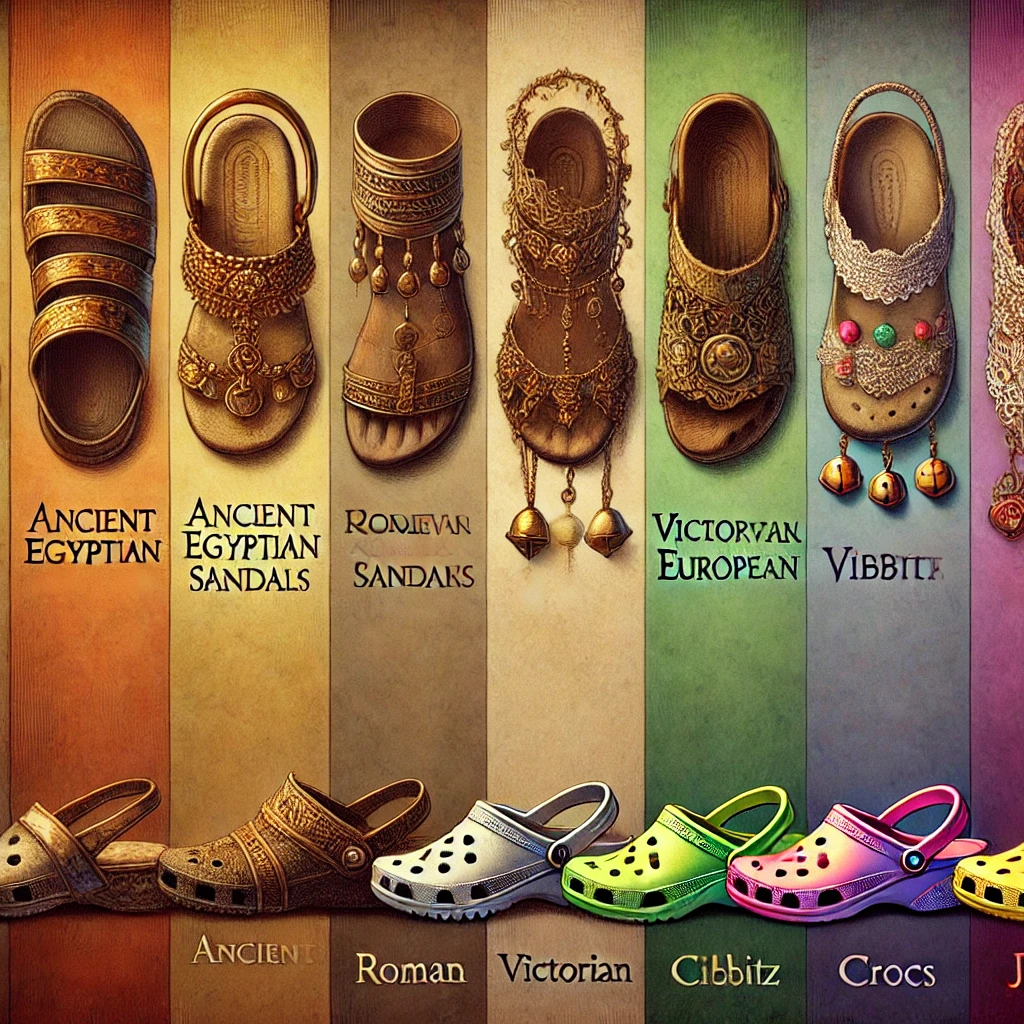
The History of Slipper Charms: From Ancient Times to Modern Fashion
Throughout history, humans have always found creative ways to express their identity and adorn themselves. Footwear, a fundamental aspect of daily life, has not only been a practical necessity but also a canvas for cultural, artistic, and personal expression. Among the many ways footwear has been enhanced, the evolution of slipper charms stands out as a fascinating tale that intertwines culture, craftsmanship, and modern trends. In this blog, we’ll journey through the history of slipper charms, tracing their origins from ancient times to their current role in contemporary fashion.
Ancient Origins: Footwear as a Canvas
In ancient civilizations, footwear was more than a means of protection; it was a statement of social status and cultural identity. Adornments and decorations on shoes signified wealth, power, or affiliation with a particular group.
1. Egyptian Sandals
In ancient Egypt, footwear was a symbol of status. Sandals made of papyrus or leather were worn by the elite, often adorned with intricate patterns or precious materials. While slipper charms as we know them today did not exist, decorative embellishments such as gold threads, beads, and symbolic carvings were used to personalize footwear.
2. Roman Footwear
Romans introduced the concept of customizing footwear for both functionality and fashion. Soldiers’ sandals, for instance, featured studs and patterns that often reflected their rank or legion. Wealthy citizens adorned their footwear with bronze or silver accents, which could be seen as precursors to modern slipper charms.
3. Asian Influence
In ancient China and Japan, footwear such as lotus shoes and geta sandals often featured elaborate designs and decorations. These embellishments, including embroidered symbols or dangling ornaments, served as precursors to today’s slipper charms, embodying cultural beliefs and artistic expression.
Medieval and Renaissance Europe: The Rise of Ornamental Footwear
During the medieval period, the concept of shoe decoration evolved further. Footwear became an indicator of social hierarchy, with elaborate designs reserved for the aristocracy.
1. Pointed Shoes and Pomanders
In the Middle Ages, pointed shoes known as poulaines became popular among the European elite. These shoes were sometimes adorned with small bells or pomanders, which can be seen as an early form of footwear charms. Pomanders served a dual purpose: decoration and masking unpleasant odors.
2. Renaissance Opulence
The Renaissance brought a renewed focus on art and fashion. Shoes were crafted with luxurious materials like velvet and silk and were often adorned with jewels, embroidery, and metallic accents. These embellishments reflected the wearer’s wealth and taste, much like modern slipper charms do today.
18th and 19th Century: A Shift Towards Personalization
As industrialization transformed fashion, footwear became more accessible to the masses. This democratization of fashion paved the way for personalization and decorative trends in shoes.
1. Buckles and Clips
In the 18th century, shoe buckles became a fashionable accessory. Made of silver, gold, or enamel, these buckles allowed individuals to customize their footwear. While not technically charms, they marked a significant step towards decorative additions to shoes.
2. Victorian Embellishments
During the Victorian era, shoe decorations became more intricate. Ribbons, lace, and small trinkets were often added to footwear, reflecting the romantic and elaborate fashion of the time. These adornments foreshadowed the rise of modern slipper charms as a way to enhance footwear with personal touches.
20th Century: The Birth of Modern Slipper Charms
The 20th century saw significant shifts in fashion, driven by technological advancements, cultural movements, and changing lifestyles. Slipper charms began to emerge as a distinct fashion accessory.
1. The 1950s: Post-War Creativity
In the post-war era, fashion became more playful and experimental. Customizable elements, such as clip-on shoe decorations and appliqués, gained popularity. These accessories allowed individuals to express their style without investing in multiple pairs of shoes.
2. The 1980s: Pop Culture Influence
The 1980s brought a surge of bold, colorful fashion influenced by pop culture. Novelty charms and embellishments became a fun way to personalize shoes, particularly for younger audiences. Brands began to experiment with playful designs, including cartoon characters and glittery elements.
21st Century: The Golden Age of Slipper Charms
In the 21st century, slipper charms have reached new heights of popularity. With advancements in materials, manufacturing, and e-commerce, slipper charms have become a global phenomenon.
1. The Rise of Crocs and Jibbitz
One of the most significant milestones in the history of slipper charms was the introduction of Jibbitz by Crocs in the early 2000s. These small, colorful charms were designed to fit into the ventilation holes of Crocs shoes, offering endless customization options. Jibbitz transformed slipper charms into a mainstream fashion accessory, appealing to both children and adults.
2. Social Media and Personalization
The rise of social media platforms like Instagram and Pinterest has fueled the popularity of slipper charms. Influencers and fashion enthusiasts showcase their unique combinations of charms, inspiring others to create personalized looks. This trend aligns with the growing demand for individuality in fashion.
3. Luxury Brands Enter the Scene
High-end fashion brands have also embraced slipper charms. Designers like Gucci and Prada have introduced charms and embellishments for their footwear lines, elevating the accessory to a new level of sophistication. These luxury charms often feature premium materials like gold, diamonds, and intricate craftsmanship.
4. Themes and Occasions
Today, slipper charms cater to various themes and occasions. From seasonal motifs like snowflakes and pumpkins to hobby-themed charms representing sports or music, the possibilities are endless. This versatility has made slipper charms a favorite for gift-giving and personal expression.
Cultural Significance: Beyond Fashion
While slipper charms are primarily seen as a fashion accessory, they also hold cultural significance in many parts of the world. In some cultures, charms are believed to bring good luck, ward off evil spirits, or symbolize important life events. By incorporating these elements into footwear, individuals can carry their beliefs and stories with them wherever they go.
The Future of Slipper Charms
As technology and fashion continue to evolve, the future of slipper charms looks bright. Here are some trends to watch for:
1. Smart Charms
The integration of technology into fashion has already begun. Imagine slipper charms equipped with Bluetooth connectivity, allowing you to track your steps or receive notifications. These smart charms could combine style with functionality, appealing to tech-savvy consumers.
2. Sustainability
With increasing awareness of environmental issues, sustainable slipper charms made from recycled or biodegradable materials are likely to gain popularity. Brands that prioritize eco-friendly practices will resonate with conscious consumers.
3. 3D Printing
Advancements in 3D printing technology could revolutionize the slipper charm industry. Consumers could design and print their own charms, enabling unparalleled levels of personalization and creativity.
